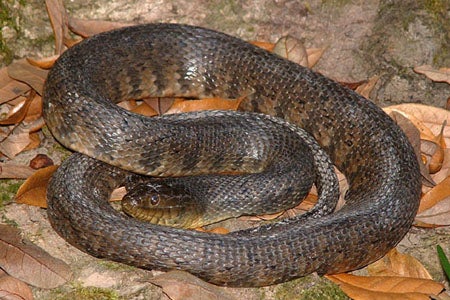SCIENTIFIC NAME:
Nerodia cyclopion
STATUS:
Peripheral and fairly common in Southern Coastal Plain from Tensaw Delta westward. A large snake of forested swamps, oxbows, and sluggish, tree-lined streams, where it may be found as far as 97 kilometers (60 miles) inland from coastal areas. Less frequently encountered in lower Mobile Bay area, where forest gives way to marsh and grass flats. Low Conservation Concern.
DESCRIPTION:
Mississippi green water snakes (Nerodia cyclopion) are medim sized snakes, 30-45 inches in length, and no distinctive field marks. They do, however, have a row of scales between the eyes and lips which positively identifies them. They are green to brown with some darker pigmentation on their dorsal (top) side. Their belly has light spots resembling half-moons against a uniform gray or brown background. Their scales are keeled and the anal scale is divided.
DISTRIBUTION:
Mississippi green water snakes range from extreme southern Illinois down the Mississippi Valley to the gulf coast. They also are found in coastal areas westward into Texas and eastward to the extreme western Florida panhandle. In Alabama, they are found only in Mobile and Baldwin Counties.
HABITAT:
Mississippi green water snakes prefer calm waters such as lakes, ponds, swamps, marshes, or bayous. They sometimes are found in brackish waters along the gulf coast.
FEEDING HABITS:
Mississippi green water snakes, like most water snakes, prefer to feed on fish, but also will eat crayfish, frogs, and toads when they are available.
LIFE HISTORY AND ECOLOGY:
Mississippi green water snakes, like other water snakes, bear live young. This is believed to be an adaptation to prevent their eggs from being destroyed by flood waters. They breed in April or May, and give birth to 8-34 young in August or September. Hatchlings resemble adults and are 9-11 inches long.
REFERENCES:
Cognant, R., and J.T. Collins. 1998. Reptiles and Amphibians Eastern/Central North America. Houghton and Mifflin Co., Boston, MA. 616 pp.
http://www.pingleton.com/LifeSnakes/cyclopion.htm
Author:
Chas Moore, Wildlife Biologist, Alabama Division of Wildlife and Freshwater Fisheries






